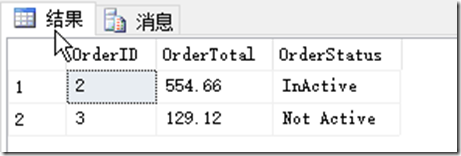null是什麼? 不知道。我是說,他的意思就是不知道(unknown)。 它和true、false組成謂詞的三個邏輯值,代表“未知”。與true和false相比,null最難以令人捉摸,因為它沒有明確的值,在不同的場景下,它能代表不同的含義。下文以例子的方式給大家分享下null使用的典型場景及對應的
null是什麼?
不知道。我是說,他的意思就是不知道(unknown)。
它和true、false組成謂詞的三個邏輯值,代表“未知”。與true和false相比,null最難以令人捉摸,因為它沒有明確的值,在不同的場景下,它能代表不同的含義。下文以例子的方式給大家分享下null使用的典型場景及對應的用法。
1.check約束與null
之前在SQL ServerCentral.com上看到一個關於check約束的null問題,
作者創建了一個表,在欄位orderstatus上設置了check約束,只能插入指定的value的行,現在插入幾行數據,其中有一行的value為null,最後問最終有幾行可以插入成功。
原文如下:
I want to ensure that the status column for my Orders table only contains specific values. I decide to use this code:
create table Orders ( OrderID int primary key , OrderTotal MONEY , OrderStatus VARCHAR(20) constraint Orders_Status_Code check( OrderStatus in ('ACTIVE', 'INACTIVE', 'TBD')) ); go
Now I want to insert data into the table. I run this batch.
insert Orders select 1, 435.43, 'Active' insert Orders select 2, 554.66, 'InActive' insert Orders select 3, 129.12, 'Not Active' insert Orders select 4, 1228.00, NULL
How many rows are in the table? I am running on a default, SQL Server 2014 instance with US English defaults.
(大家先想想答案,如果沒有把握就找個測試環境試一試)
《T-SQL基礎教程》中關於check約束與null的描述,著者用了一句言簡意賅的口訣“check約束拒絕false,接受true和null”。
在上面的例子中,當orderstatus為‘Avative’和’InActive’時,check約束判斷的結果是true,所以會插入成功,當為'Not Active’判斷的結果為false,插入不成功,最後當為'Null’時,判斷的結果是null,插入成功。
所以,正確答案是3。
2.比較運算與null
null一個特殊性在於它無法比較(和計算)。null與任何值的任何比較(和計算)都等於null。(unique約束除外,在unique約束中,null是相等的,同一個欄位不允許出現兩次null)
比如判斷null=null的結果是null,判斷null<>null的結果也還是null。下麵我以不等於(<>)為例,演示比較運算對null的判斷。
我先創建一個表,然後插入多行數據,其中有一行orderstatus的值為null,
if object_id(N’Orders’) is not null drop table orders
create table Orders ( OrderID int primary key , OrderTotal MONEY , OrderStatus VARCHAR(20) ); go
insert Orders select 1, 435.43, 'Active' insert Orders select 2, 554.66, 'InActive' insert Orders select 3, 129.12, 'Not Active' insert Orders select 4, 1228.00, NULL
現在我執行了一個where orderstatus<>'Active' 的查詢,
select * from orders where OrderStatus<>'Active'
大家想想null所在的行會不會在查詢結果裡面。
在上面的例子中,當orderstatus為'InActive' 和'Not Active' 時,where條件判斷的結果為true,但當orderstatus為'null' 時,where OrderStatus<>'Active'等價於where null <>'Active',而null與任何一個值的比較結果還是null,所以where條件判斷的結果為null。
在SQL Server中,where篩選的原則是“接受true,拒絕false和null”(《T-SQL基礎教程》)。所以orderstatus為'InActive' 和'Not Active'的行顯示在結果集總,而orderstatus為null的行不會出現在結果集中。
最終,正確答案是:只會返回兩行
3.Not in與null和Not exists與null
not in和not exists都可以用來判斷某個對象的存在與否,在大多數場景下兩者可以相互替換,但在遇到null時,因為前者是三值邏輯(true|false|unknow)判斷而後者只會返回true或false,因此處理的結果會有很大不同。
為了演示兩者的區別,我們還是沿用上文的表,分別使用not in和not exists執行一個查詢,找出OrderStatus 不為'Active'和'InActive'的行。
if object_id(N’Orders’) is not null drop table orders
create table Orders ( OrderID int primary key , OrderTotal MONEY , OrderStatus VARCHAR(20) ); go
insert Orders select 1, 435.43, 'Active' insert Orders select 2, 554.66, 'InActive' insert Orders select 3, 129.12, 'Not Active' insert Orders select 4, 1228.00, NULL
3.1Not In與null
在下麵這個查詢中,where子句中使用not in來過濾數據,where子句的條件是OrderStatus not in ('Active','InActive'),我們期望結果集中包含orderstatus為'Not Active'、'NULL'這兩行的數據。
select * from orders where OrderStatus not in ('Active','InActive')
這個查詢中,當OrderStatus為null時, 原where子句等價於where null <>'Active' OR null<>'InActive',這就變成了上文中介紹的比較運算與null的問題。where的判斷結果還是null,所以該行不會出現在結果集中。而當OrderStatus為'Not Active'時,滿足where篩選的為true的條件,會顯示在結果集中。
最終,正確答案是:只有一行。
說明:in與null的關係與此同理。
3.2Not exists與null
現在我們還是期望結果集中包含orderstatus為'Not Active'、'NULL'這兩行的數據,這次用Not exists。
在這個查詢中,子查詢先求出OrderStatus='Active' or OrderStatus='InActive的行,然後外部查詢用not exists過濾子查詢的結果,將剩下的行顯示在最終結果集中。
SELECT * FROM orders AS o1 WHERE NOT EXISTS( SELECT * FROM orders AS o2 WHERE o1.OrderStatus = o2.OrderStatus AND ( o2.OrderStatus = 'Active' OR o2.OrderStatus = 'InActive' ));
為了方便理解,我們將子查詢改寫成自表連接的方式,
select * from orders as o2 where o1.OrderStatus=o2.OrderStatus and (o2.OrderStatus='Active' or o2.OrderStatus='InActive' ))
改寫成:
SELECT * FROM orders AS o2 INNER JOIN orders o1 ON o1.OrderStatus = o2.OrderStatus AND ( o2.OrderStatus = 'Active' OR o2.OrderStatus = 'InActive' );
返回的結果集為:
然後我們再看外層查詢,
外部查詢期望使用not exists返回orders表中不包含子查詢結果集的行,也就是說,只要orders表沒有子查詢結果集中的行就返回true,否則返回false(只有存在和不存在,沒有unknown的說法)。
按照這個邏輯,orderID為3和4的行不在子查詢的結果集中,因此not exists判斷為true,而orderID為1和2的行已包含在子查詢的結果集中,所以not exists判斷為false。最後根據where篩選“接受true,拒絕false和null”的原則,最終只有orderID為3和4的行顯示在結果集中。
說明:exists與null的關係與此同理。
3.3Not in和Not exists的區別
not in實際上是對一個對象的比較運算,而比較存在true|false|unknow三種邏輯值。
not exsits判斷某個對象存在或者不存在,它只有這兩種狀態,沒有unknown的說法。因此相比not in而言,not exists只會有true和false這兩種邏輯值。
總結:
上文介紹了null在不同場景中的含義,考慮到SQL不同的語言元素對null的不同處理方式,平常我們在寫SQL語句的時候應該清晰思考自己編寫的每個查詢對null或三值邏輯的處理,避免出現邏輯錯誤。








